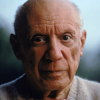Pablo Picasso

Pablo Picasso
Pablo Ruiz y Picasso, also known as Pablo Picasso, was a Spanish painter, sculptor, printmaker, ceramicist, stage designer, poet and playwright who spent most of his adult life in France. Regarded as one of the greatest and most influential artists of the 20th century, he is known for co-founding the Cubist movement, the invention of constructed sculpture, the co-invention of collage, and for the wide variety of styles that he helped develop and explore. Among his most famous works are...
NationalitySpanish
ProfessionPainter
Date of Birth25 October 1881
CityMalaga, Spain
CountrySpain
Motivation is in the world around us. We have an infinite amount of material at our disposal, in the lives of those we meet, in what we see and feel, in what we discuss and from the passion of every woman.
[In developing your potential] ... I don't develop; I am
I put in my pictures everything I like. So much the worse for the things - they have to get along with one another.
The secret of many of my deformations - which many people do not understand - is that there is an interaction, an intereffect between the lines in a painting: one line attracts the other and at the point of maximum attraction the lines curve in toward the attracting point and form is altered.
It would be very curious to record by means of photographs, not the stage of the picture, but its metamorphoses. Perhaps one would perceive the path taken by the mind in order to put its dreams into a concrete form. But what is really very curious is to observe that fundamentally the picture does not change, that despite appearances the initial vision remains almost intact.
For being a bad student I was banished to the 'calaboose' - a bare cell with whitewashed walls and a bench to sit on. I liked it there, because I took along a sketch pad and drew incessantly I could have stayed there forever drawing without stopping
For a long time I limited myself to one colour—as a form of discipline.
Museums are just a lot of lies, and the people who make art their business are mostly imposters. We have infected the pictures in museums with all our stupidities, all our mistakes, all our poverty of spirit. We have turned them into petty and ridiculous things.
An artist must be very careful not to look for models. As soon as one artist takes another as model, he is lost. There is no other point of departure than reality.
It is my misfortune - and probably my delight - to use things as my passions tell me. What a miserable fate for a painter who adores blondes to have to stop himself putting them into a picture because they don't go with the basket of fruit! . . . I put all the things I like into my pictures. The things - so much the worse for them. They just have to put up with it.
If you give a meaning to certain things in my paintings it may be very true, but it is not my idea to give this meaning. What ideas and conclusions you have got I obtained too, but instinctively, unconsciously. I make the painting for the painting. I paint the objects for what they are.
Whatever is most abstract may perhaps be the summit of reality.
To arrive at abstraction, it is always necessary to begin with a concrete reality.
Forcing yourself to use restricted means is the sort of restraint that liberates invention. It obliges you to make a kind of progress that you can't even imagine in advance.